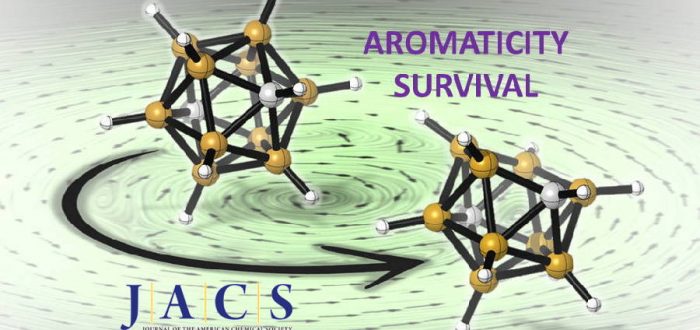Whereas the aromaticity of closo boranes is widely accepted, less is known about the aromaticity of nidoboranes. This work carried out by Prof. Francesc Teixidor, Prof. Clara Viñas, and Dr. Ines Bennour of the Institute of Materials Science of Barcelona (ICMAB-CSIC), Prof. Jordi Poater at the University of Barcelona (previous DiMoCat member) and Sílvia Escayola and Prof. Miquel Solà members of the DiMoCat group of the Institute of Computational Chemistry and Catalysis of the University of Girona, experimentally shows that deboronation of m-C2B9H12 is a difficult task, whereas deboranation of o-C2B9H12 is quite easy. Moreover, it is widely known that o-C2B10H12 isomerizes to m-C2B10H12 upon heating at 400 ºC. These two facts indicate that m-C2B10H12 is more stable than o-C2B10H12. To find a reason for the different stability of these two isomers, authors have analyzed the thermodynamic stability and aromaticity of these closo carboranes and their nido counterparts. Results show that the higher thermodynamic stability of m-C2B10H12 is not related to aromaticity differences but to the location of the C atoms in the carborane structure. It is also demonstrated that the aromaticity observed in closo boranes and carboranes is also present in their nido counterparts and, consequently, authors conclude that aromaticity in boron clusters survives radical structural changes. Further, sandwich metallocenes (e.g. ferrocene) and sandwich metallacarboranes (e.g. [Co(C2B9H11)2]–) have traditionally been considered similar. In this work, it is shown that they are not. Metallacarboranes display global aromaticity, whereas metallocenes present local aromaticity in the ligands. Remarkable and unique is the double probe given by 1H- and 11B-NMR tracing the reciprocally antipodal endocyclic open face Hec and B1. These magnetic studies have permitted to correlate both nuclei and relate them to a diatropic current in the plane at the middle of the nido-[C2B9H12]–. This observation is the first and unique data that proves experimentally the existence of diatropic currents, thence aromaticity, in nido clusters and is comparable to the existence of diatropic currents in planar aromatic compounds. The paper was published recently in Journal of the American Chemical Society.
J. Poater, C. Viñas, I. Bennour, S. Escayola, M. Solà, and F. Teixidor
“Too Persistent to Give Up: Aromaticity in Boron Clusters Survives Radical Structural Changes”
J. Am. Chem. Soc. 2020, ASAP-
DOI: 10.1021/jacs.0c02228
- sec.iqcc@udg.edu
- +34 972 41 83 57

